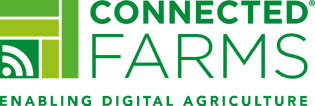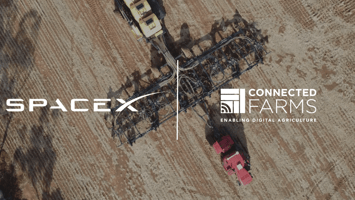21st April 2023, Northern NSW, Australia.
Connectivity Explained for Farmers: What is LoRaWAN?

Modern farming businesses are increasingly gathering and collecting more data across their farms and orchards to improve productivity and reduce costs. Unfortunately, rural areas often suffer from limited connectivity and coverage, making even simple phone calls or sending messages challenging, let alone gathering farm data and information from anywhere. This often means as a farming business, you may need to explore connectivity options to overcome this challenge. Quickly you will be exposed to a lot of jargon, such as LoRaWAN, IoT, Narrowband, Broadband, Mesh Wi-Fi, LEOSat, the list goes on. Deciphering this jargon and navigating the maze to learn what is best for your farm can be overwhelming.
We will unpack connectivity terminology and what it means for farmers in our “Connectivity Explained for Farmers” series. With that in mind, what is LoRaWAN?
What is LoRaWAN and its Significance on Farms?
LoRaWAN is a wireless communication technology. The "LoRa" part stands for "Long Range," which highlights its ability to cover vast distances. The "WAN" part stands for "Wide Area Network," which simply means it can connect devices over a large area, like an entire farm. It sends small amounts of data over long distances.
It enables long-range communications at a low bit rate (data is being transmitted at a slower rate), making it ideal for applications that require long battery life and operate in remote or hard-to-reach locations with small data packages such as sensors.
For farmers, this means you can gather and transmit small amounts of data from various sensors and devices over long distances with minimal power consumption. It can be an ideal solution for monitoring crops, livestock, soil, and water.
Real-World Applications of LoRaWAN Connectivity on Farms.
Here are a few examples of how LoRaWAN is being used on farms.
Soil Moisture Monitoring
LoRaWAN-enabled soil moisture sensors can send soil data, helping farmers optimise irrigation and water usage.
Livestock Tracking
Track the location and health of livestock with LoRaWAN, often via wearables such as collars and tags. It can be used to maximise the health, rumination, and productivity of your animals.
Weather Stations
Installing weather stations with LoRaWAN connectivity allows you to receive weather updates and forecasts about the microclimates found on your farm.
Crop Monitoring
LoRaWAN sensors can detect changes in plant health, alerting you to potential issues like disease or pest infestation early on.
Soil Moisture and Nutrient Monitoring
LoRaWAN sensors placed in the field send data on soil conditions, helping you make informed decisions about irrigation and fertilisation.
Limitations of LoRaWAN on Farms.
While LoRaWAN is a versatile technology, it does come with its own set of limitations. The technology is designed for low power consumption and long-range communication, which means it's not suited for high bandwidth applications. In simpler terms, it's great for sending small amounts of data like sensor readings but not for transferring large files, making phone calls/messages, real-time data management, or video streaming unfeasible. Additionally, the network coverage in remote or rural areas might be limited, depending on the presence and distance range of LoRaWAN gateways.
Coverage and Range
LoRaWAN's range depends on various factors, including the terrain and the presence of obstacles, such as buildings and thick canopies found in orchards. In some cases, signal boosters or additional gateways may be necessary to ensure full coverage.
Interference
Radio interference from other devices can disrupt LoRaWAN communications, requiring careful planning.
Power Supply
Devices connected to LoRaWAN need a power source. However, LoRaWAN's low-power consumption is an advantage, as it allows devices to run for extended periods.
Data Rate
LoRaWAN is not designed for high-data-rate applications. Streaming video or large files is beyond its capabilities.
Challenges and Considerations with LoRaWAN on Farms.
Implementing LoRaWAN on your farm requires careful planning.
Coverage
Ensure your farm is within range of a LoRaWAN gateway or consider installing your own.
Device Compatibility
Choose sensors and devices that are compatible with LoRaWAN and meet your specific farm needs.
Cost
While LoRaWAN devices have low operational costs, the initial setup and investment in sensors and gateways can be significant. Will these sensors meet your farm's needs in a couple of years? Sadly, we see cases where significant investments on farms are made on LoRaWAN sensors and they can become redundant after a few years, so research and cost-analysis are important.
Technical Know-how
Setting up and maintaining a LoRaWAN network might require some technical knowledge or external assistance.
Best Practices for Implementing LoRaWAN on Farms.
To ensure successful implementation of LoRaWAN on your farm, consider the following best practices.
Identify the primary objectives of your monitoring efforts.
Different scenarios may necessitate the use of varied sensors. For instance, LoRaWAN sensors are versatile and can track a range of environmental factors such as temperature, soil moisture, and wind speed, among others. Consider which metrics are most crucial for your farm to help reduce costs, and whether there are existing measurements that could benefit from more frequent data transmission.
Site Survey
Before deployment, conduct a site survey to understand signal strength and potential obstacles. This will help in optimal gateway placement.
Choosing an Appropriate Gateway
For operations in areas with limited or non-existent cellular coverage, selecting a gateway capable of utilising alternative communication methods, such as satellite links, is essential. This ensures that collected data can be transmitted to you without the need for time-consuming trips to the site. A durable and reliable gateway is key to maintaining consistent communication in isolated areas.
Seek Advice
Don't hesitate to consult with connectivity experts or companies specialising in agricultural connectivity for guidance and support.
Leveraging Collected Data
Once environmental and farm-related data have been gathered, it becomes accessible to farmers. At this stage, data analysis of the gathered data is where you will maximise the ROI on your LoRaWAN implementation.
What Does This Mean for Your Farm?
Harnessing the power of long-range, low-power wireless communication on your farm can open possibilities for improving efficiency, productivity, and sustainability. By leveraging data and insights, you can make informed decisions that benefit your crops, livestock, and bottom line.
It is important to consider your use cases on your farm and what you are hoping to achieve. Small data packets collected from sensors are where LoRaWAN shines, but for large data files or instant real-time information, LoraWAN wouldn’t work effectively.
High Bandwidth Requirements: For farm operations that require the transmission of large data files, or high-resolution images or video streams, such as remote monitoring of machines, livestock or crop conditions, and phone calls and messages, LoRaWAN will not be suitable due to its limitations.
Real-Time Control Systems: LoRaWAN generally experiences higher latency (the amount of time it takes for a signal to travel from its source to its destination, higher means longer) compared to other communication technologies like Wi-Fi or cellular networks. This is a drawback for applications requiring real-time feedback or control, such as automated irrigation systems that adjust water flow based on immediate soil moisture readings or system controls for precision farming technology or autonomous and robotic machines and implements. The delay in communication might hinder the effectiveness of such systems, and for high data use cases, it simply will not work at all.
Conclusion
LoRaWAN presents a viable solution for modern farming businesses facing connectivity challenges, particularly in rural and remote areas. By enabling long-range, low-power wireless communication, LoRaWAN supports the collection and transmission of small data packets from various sensors across your farm. This technology is particularly beneficial for monitoring crops, livestock, soil, and water conditions, thus enhancing farm efficiency and productivity.
However, it is crucial for farmers to understand LoRaWAN's limitations, such as its unsuitability for high bandwidth applications and real-time control systems. With careful planning, consideration of farm-specific needs, and adherence to best practices for implementation, LoRaWAN can significantly contribute to the digital transformation of agriculture, making it an essential tool for farmers navigating the complexities of modern farm management.
About Connected Farms
Connected Farms Pty Ltd is a company dedicated to providing reliable and appropriate connectivity solutions to the agriculture sector. Located in Regional NSW, Regional South Canterbury NZ, and Regional Scotland our mission is to connect farmers, growers, agribusinesses, and fisheries to enable digital agriculture, enhancing productivity, safety, and sustainability in farming operations across Australia, New Zealand, and the UK. For more information visit www.connectedfarms.co



.jpg?height=200&name=IMG-7539%20(1).jpg)
.png?height=200&name=SOTM%20launch%20quote%20(2).png)